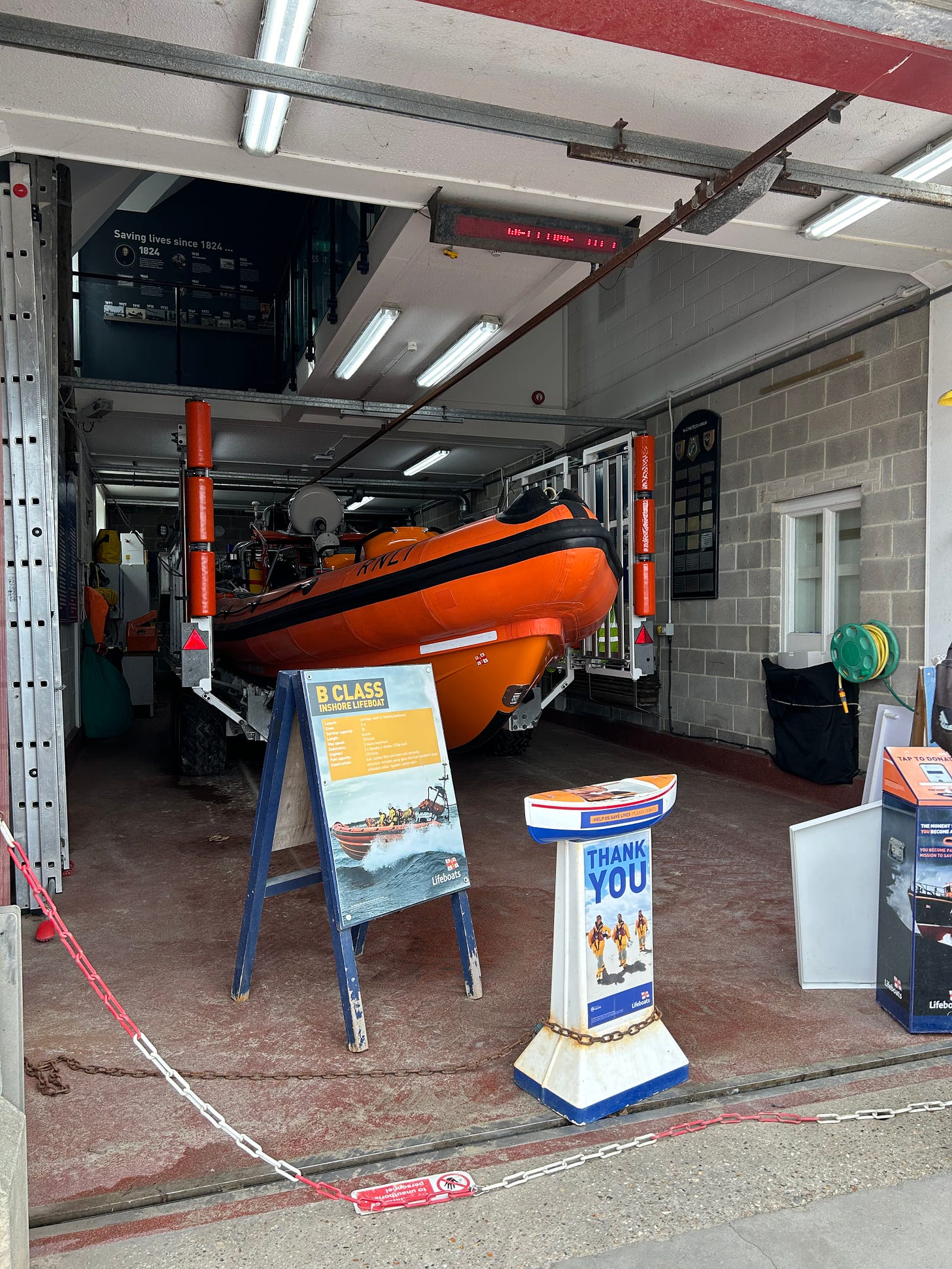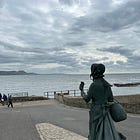Welcome to part two of my Lyme Regis exploration.
Last week I left you at Harbour Inn, so now it’s time to collect you and explore more of this lovely seaside town.
Marine Parade, Lyme Regis
Harbour Inn is on the Marine Parade, a paved walk along the seafront from the bottom of the town centre, starting at the small Cobb Gate Car Park, where you will find the Millennium Clock. It then runs to the harbour known as The Cobb. The Harbour Inn is toward the far end.
Look out for the street lights with the ammonite scrolls on this walk. There are some lovely homes along here, some of which are available as holiday accommodation. You will come across the long row of brightly coloured beach huts. The British enjoy sitting in a small wooden shed by the sea! These are for hire, and in some places, people will pay thousands of pounds for the pleasure of owning one. I was hoping to get the classic full-length view, but a group of photographers were in action and taking it in turns to spend ages taking photos! So, for the photo below, I sneaked in between them and one end for this shot.
The only amusement arcade I know of in Lyme Regis is on Marine Parade, which is good. The more amusement arcades, the tackier the town, is my experience. Rising behind the arcade and shops on the hillside is a park, Alexander Garden and Woodland Walk. The National Trust has a shop near the arcade. I have always loved entering an NT shop, but I managed to walk past this time!
The beach runs along the front of this walk, so there are plenty of places to buy food and drink to stay refreshed on a hot or cold day (this is England!). Before heading to Monmouth Beach to look for fossils, let's walk around The Cobb.
This is a paywalled post. You'll be able to read the first several paragraphs. After that, you'll have to become a paying subscriber to continue reading. I hope you'll consider converting so you can read all of my posts in their entirety. This newsletter is 100% supported by readers like you. In any case, many thanks for being here.
The Cobb - Lyme Regis’ Harbour
The Cobb has a long history. According to the Visit Dorset website, it has yet to be discovered why it has this name. The first recording of the name goes back to 1294, although it probably existed well before then.
Click on any photo to see the whole image.







The Cobb was once just built from piles of boulders and oak plies. It has been washed away many times. In 1685, one writer described it as an “immense mass of stone of a shape of a demilune, with a bar in the middle of a concave: no one stone lies there that has ever touched with a tool or bedded in any sort of cement.” Further back in time, in 1328, a document described it as “been damaged by storms”.
Below is a video I captured a few years ago.
Although the sea may look calm to most visitors, it can rage violently, and on such days, do not attempt to get close to the sea or walk on the harbour walls. The Cobb, during its life, has suffered from storm damage. In 1377, it was washed away, along with 50 boats and 80 houses. The Cobb suffered from other storms, and in 1826, it was reconstructed using Portland Admiralty Stone, a type of Portland Stone. It is now, of course, far more robust to withstand the ravages of the sea.
The lifeboat station is based in one corner of the harbour and is open for visitors to enter and look down at the lifeboat from the gallery inside. The RNLI also has a small shop alongside. With the number of visitors and boats in the area, this is a busy lifeboat station and has assisted many who have found themselves in trouble at sea or along the beach and cliffs.
Shipbuilding and Trade
I found it interesting that Lyme Regis was once a major shipbuilding centre and busy port. Shipbuilding was a big business from the 13th century and very successful between 1780 and 1850. Nearly 100 ships were built.
There was much trade with France; the most prosperous period was from the 16th century to the end of the 18th. Here’s a little-known fact. In 1780, Lyme Regis’ port was greater than the Port of Liverpool. With technological progress, ships got larger, and Lyme Regis could no longer handle such vessels, so the port declined. There is some fishing today, but it’s mainly used for pleasure craft. Visitors can take a boat ride for a bay tour or hire a boat for a day’s fishing. You will see signs opposite the lifeboat station offering you this opportunity.
If you like fish to look at, there is a small aquarium on The Cobb. This is situated in an early 18th-century building. It opened in the late 1950s, and you will see fish found around the local coastline. You can hand-feed the mullet; it is probably the only place to do this.


Notice the sign next to Lyme Regis Aquarium (photo below) showing the charges on goods landed at the port in 1879. The clerk to The Cobb, Mr Atkins, was a busy man. Searching the records, he ran an insurance office in Broad Street. That’s the street where most of the shops are today.
My next move is to leave The Cobb and walk west along Monmouth Beach. Firstly, this takes me through the car park, and here are a couple of classic cars parked which just cried out to be photographed—a nice E-Type Jaguar with its 4.2-litre engine and a 1967 Humber Hawk 2.2-litre estate.


Although the boatbuilding business has faded, seeing a boat-building academy close to where these two cars were parked is pleasing. The Boat Building Academy and Furniture School are here. They offer long and short courses to anyone wishing to master these skills.
Passing the lines of static caravans and chalets for holidaymakers to hire, we make our way onto Monmouth Beach to look for fossils. I must warn you that there is a danger of severe ankle damage. The whole area is made up of small boulders, some just large enough to place a foot on, and they are at all angles, and some can wobble. The tide was well out, so check the tide times before you try this, especially if you plan the slow walk to the Ammonite Pavement. The pavement can only be accessed at low tide and by precariously walking on this beach. At the tide's edge, the rocks were covered in wet seaweed, dramatically increasing the danger of injury. With this in mind, Mrs M and I decided not to push that far. So you don’t miss out on the Ammonite Pavement, I have embedded a video below.
We discovered some fossils; an example is in the photo below. There was much excitement from the other few hardy souls around us, searching for these prehistoric remains.
There is still more to come from Lyme Regis; I will cover this in part 3. Look out for a story that may have led to the creation of a canine film star.
Thank you for being a subscriber. Don’t forget that if you refer your friends, you can receive free months of paid subscriptions. Click the refer button and let them know. They only need to become free subscribers for you to qualify.













